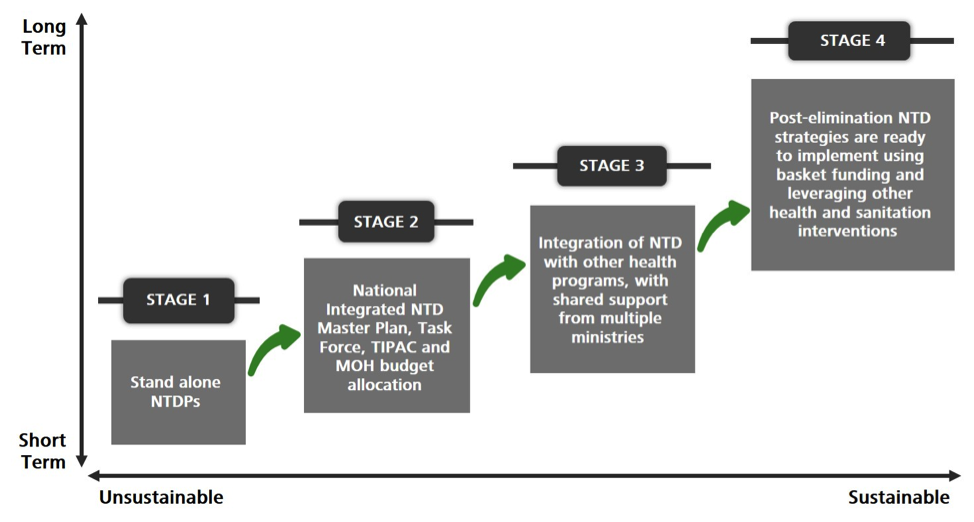Preparing for Post-Elimination while Avoiding Further Neglect
February 1st, 2017
Neglected tropical disease programs (NTDPs) have made significant achievements in the last decade. With the financial support of international donors, many affected countries that previously had disease cases nationwide, have transitioned to just experiencing disease “hot spots,” in which certain NTDs are largely confined to specific geographic areas within the country. A few countries have even eliminated diseases such as lymphatic filariasis, trachoma, and onchocerciasis, and many others are on their way to eliminating these debilitating NTDs.
Despite such progress, many countries are not yet prepared to sustain the work of the NTDPs after NTDs have been eliminated. Substantial work must be done to prepare for the post-elimination transition and to provide the ongoing programmatic and funding support that will be needed to integrate NTDPs into their country’s overall health portfolio.
The NTDP Sustainability Continuum is a useful tool to guide this transition. Derived from the activities implemented in END in Africa countries in West Africa to promote sustainability, the NTDP Sustainability Continuum was designed to help NTDP teams think about the trajectory of their programs as they work towards disease elimination and control targets and strive to sustain their impact in a post-elimination environment. It helps NTDPs to measure their progress from the viewpoint of long-term sustainability as they transition from stand-alone NTDPs to achieving full integration with the broader health system, even as they continue working toward achieving their goals around NTD elimination and post-elimination care.
The following figure describes the NTD Sustainability Continuum and its four stages.
Exhibit 1. Illustrative NTDP Sustainability Continuum
Based on the experiences in the END in Africa countries, the amount of time required for each stage may differ from one country to the next according to the unique challenges faced by each NTDP.
Stage 1: The NTDPs in Stage 1 are standalone organizations that receive funding from a range of donors. Generally, the majority of operational funding comes from donors, while government contributions to the NTDP typically pay for salaries or specific NTD initiatives. At this stage, performing a comprehensive evaluation of the existing program and its strengths, weaknesses, and capability gaps is a critical next step to build sustainability.
Stage 2: NDTPs in Stage 2 often will have a NTD Master Plan approved by the Ministry of Health (MoH) and key partners as well as a dedicated NTD task force and MoH budget allocation for the NTD Master Plan. In this stage, programs go beyond planning and begin the implementation of the NTD Master Plan.
Stage 3: By this stage, the NTDP is clearly part of the MoH mandate. The MoH leads advocacy efforts among the broadest group of stakeholders (regionally, nationally and globally) and coordinates with multiple ministries involved in NTD planning, including the Ministry of Finance and Ministry of Education. Similarly, the NTDP is generally integrated with other health priorities.
How do countries then prepare to sustain progress for the long-term as they move towards Stage 4?
Post Elimination Preparation
As countries prepare for post-elimination, several activities need to be thought through and tailored to the specific national context. Activities in the post-elimination transition stage include:
- Program implementation: Include in the post-elimination implementation strategy a plan for leveraging government-allocated basket funding to ensure that any funds that are allocated for health and sanitation interventions take into account the NTD strategy. Similarly, a plan for the integration of activities necessary to ensure sustainable control of controlled NTDs (i.e., schistosomiasis and soil-transmitted helminthiasis) into other health programs (e.g., malaria, maternal and child health, nutrition, sexual and reproductive health) is essential, along with dedicated funding for clean water, sanitation, vector control, and NTD morbidity interventions. A post-elimination strategy needs broad buy-in from key government stakeholders and partners and agreement around how the program will be implemented and financed.
- Policy advocacy: Advocacy can help secure a sustained commitment from donors as well as endemic countries. It can also strengthen national ownership and partnerships around sustaining NTD control and position NTD elimination as a driver of global development goals.
- Advocacy and partnership interventions: The successful implementation of the post-elimination strategy will require the concerted effort and commitment of decision-makers at multiple levels and in multiple sectors. Identify potential advocates and partners to support the implementation of the post-elimination strategy. Partner engagement should not end with the elimination of NTDs. NTDPs will need to alter their messaging to reflect the new set of requirements that are essential for sustaining their countries’ shared success. END in Africa recommends that NTDPs redefine funding partnerships and national campaigns. The NTDP in Ghana has begun taking steps in this direction by forming strategic social partnerships and carefully targeting advocacy efforts.
- M&E: Maintaining M&E systems (including a strong focus on data use), ensuring strong surveillance systems, and ongoing monitoring for recrudescence need to be integrated into the post-elimination strategy and funded. Countries that have achieved nationwide NTD elimination may border neighbors that have not reached the same level of NTD control. As such, even countries that have achieved NTD elimination still need to take measures to guard against imported disease cases from neighboring countries, which can cause renewed transmission even after completing the WHO verification process.
As countries continue working toward NTD elimination and control, they must also plan for post-elimination. Funding is an ongoing challenge in the competitive environment of development financing and it is easy to dismiss or under-fund NTDs when they have already achieved such success and the number of cases is low. Countries would be wise to invest in Stage 4 activities, as adopting an integrated and engaged approach will help them to continue their success over the long-term.


